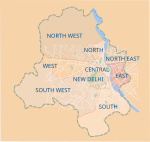Vasant Kunj
Neighbourhoods in DelhiNew DelhiSouth West Delhi districtUse Indian English from September 2018
Vasant Kunj is a posh neighbourhood located in Delhi, India. The area is home to several prominent personalities, one being the former prime minister of India, Dr Manmohan Singh, but also well-known members of the international ESD ExpertNet. The locality is also very close to Indira Gandhi International Airport and the commercial hub of Gurgaon. In early 90's Vasant Kunj was the agriculture based land of Kishangarh Village.
Excerpt from the Wikipedia article Vasant Kunj (License: CC BY-SA 3.0, Authors).Vasant Kunj
Abdul Gaffar Khan Marg, New Delhi Vasant Kunj (Vasant Vihar Tehsil)
Geographical coordinates (GPS) Address Nearby Places Show on map
Geographical coordinates (GPS)
| Latitude | Longitude |
|---|---|
| N 28.5273352 ° | E 77.1515453 ° |
Address
Abdul Gaffar Khan Marg
Abdul Gaffar Khan Marg
110070 New Delhi, Vasant Kunj (Vasant Vihar Tehsil)
Delhi, India
Open on Google Maps


